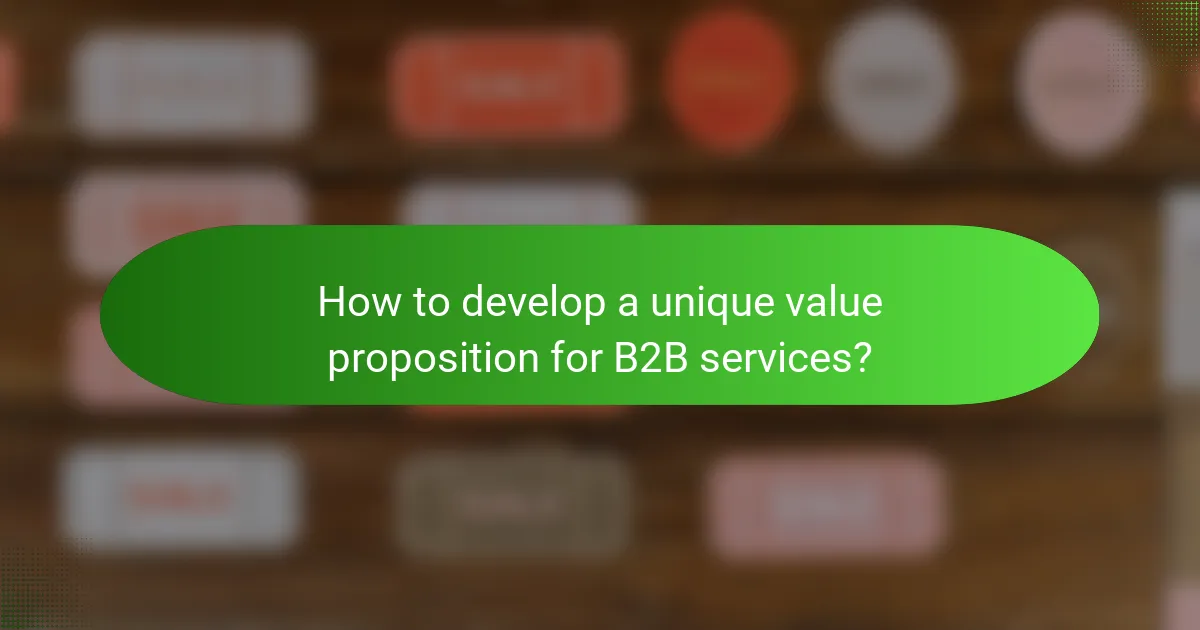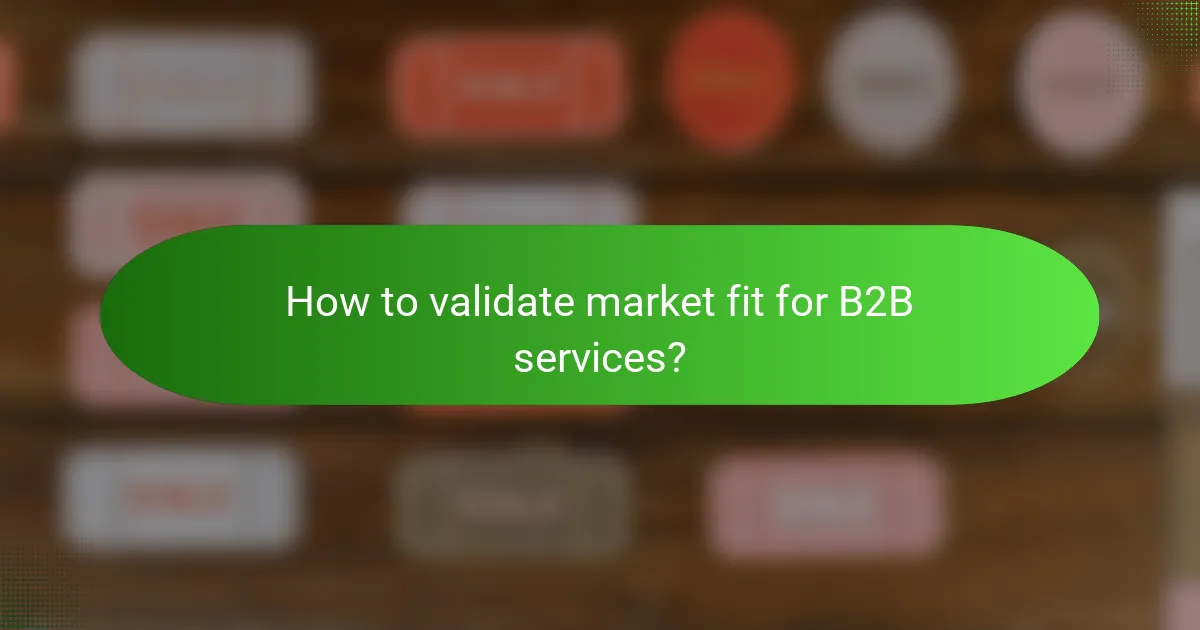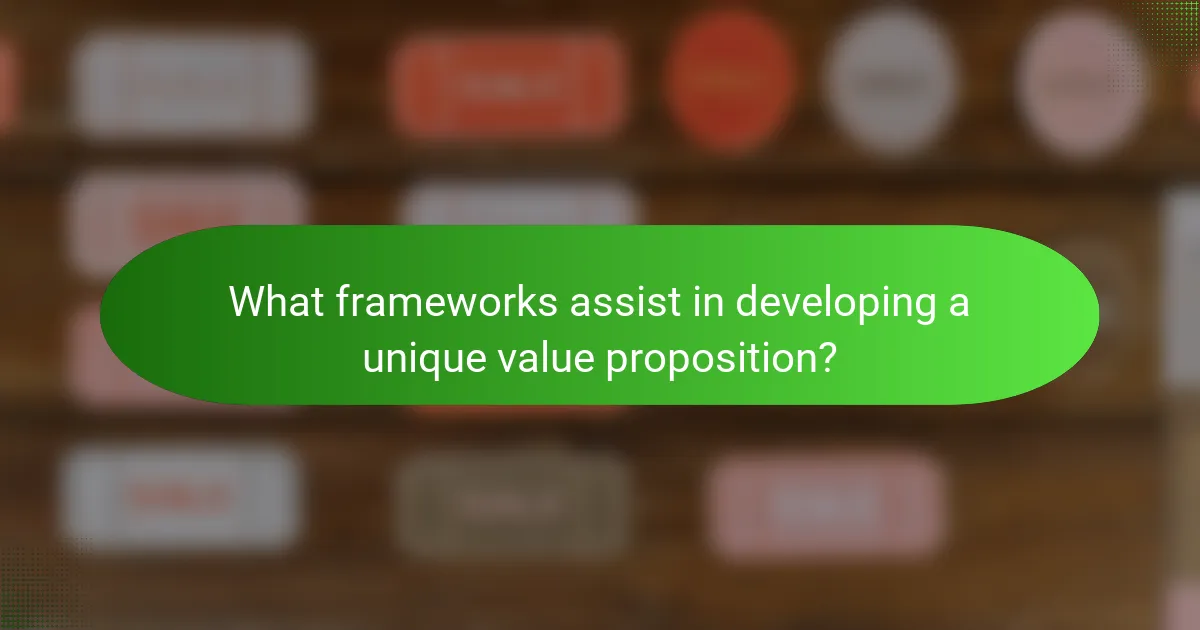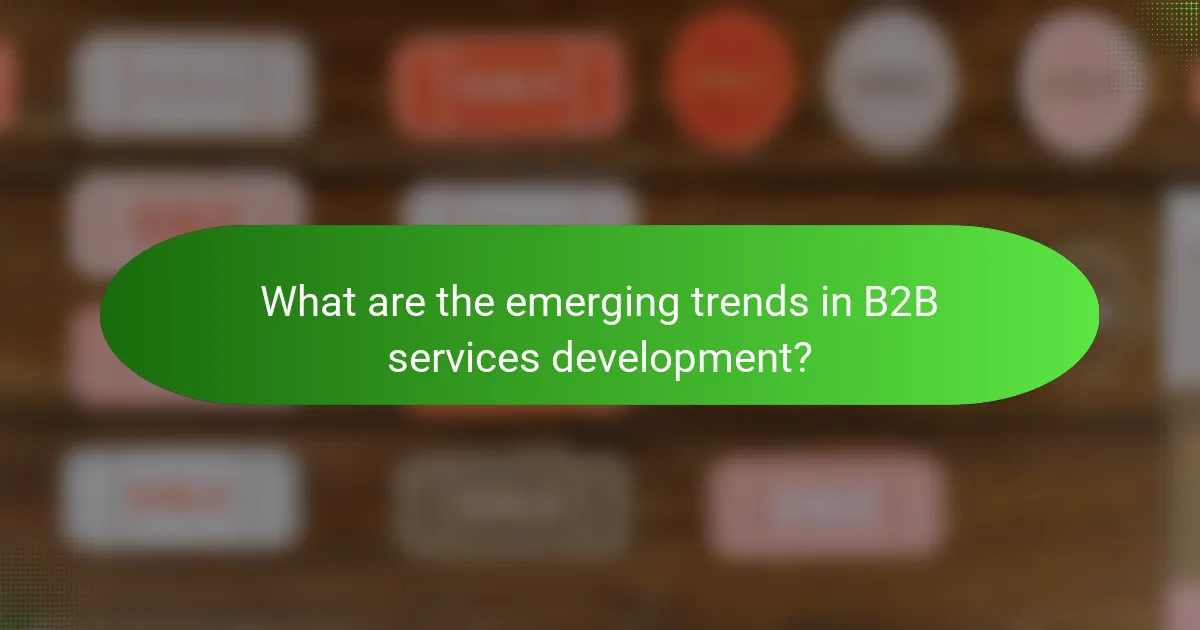Developing a unique value proposition for B2B services requires a deep understanding of your target audience’s specific problems and needs. By leveraging customer insights, you can identify pain points and desired features that guide your offerings, ensuring they resonate with potential clients. Validating market fit through testing and feedback is crucial to confirm that your services effectively meet market demands.

How to develop a unique value proposition for B2B services?
To develop a unique value proposition for B2B services, focus on clearly articulating how your offerings solve specific problems for your target audience. This involves understanding their needs, analyzing competitors, defining what sets you apart, and crafting a message that resonates with potential clients.
Identify target audience needs
Understanding the needs of your target audience is crucial for developing a unique value proposition. Conduct surveys, interviews, or focus groups to gather insights about their pain points, preferences, and expectations. This information helps tailor your services to address their specific challenges.
Consider segmenting your audience based on industry, company size, or other relevant factors. This allows for more precise targeting and ensures that your value proposition speaks directly to the unique needs of each segment.
Analyze competitor offerings
Analyzing competitor offerings helps you identify gaps in the market and understand what others are providing. Review their services, pricing models, and customer feedback to gain insights into their strengths and weaknesses. This can reveal opportunities for differentiation.
Utilize tools like SWOT analysis (Strengths, Weaknesses, Opportunities, Threats) to systematically evaluate competitors. This structured approach can highlight areas where your services can excel or offer something unique.
Define core differentiators
Core differentiators are the unique features or benefits that set your services apart from competitors. These could include specialized expertise, superior customer support, innovative technology, or cost-effectiveness. Clearly defining these differentiators is essential for a compelling value proposition.
Focus on aspects that matter most to your target audience. For example, if your clients prioritize speed, emphasize how your services can deliver results faster than competitors. Ensure these differentiators are not just claims but backed by evidence or case studies.
Craft a compelling message
A compelling message succinctly communicates your unique value proposition to potential clients. Use clear and concise language that resonates with your audience’s needs and highlights your differentiators. Avoid jargon and focus on benefits rather than features.
Test your message with a sample of your target audience to gauge its effectiveness. Use feedback to refine your messaging, ensuring it aligns with the expectations and language of your audience. A strong message can significantly enhance your marketing efforts and attract more clients.

What customer insights are critical for market fit?
Understanding customer insights is essential for achieving market fit, as they help identify the needs and preferences of your target audience. Key insights include pain points, desired features, and overall satisfaction, which guide product development and marketing strategies.
Conduct customer interviews
Customer interviews provide in-depth qualitative insights that can reveal motivations and challenges faced by users. Aim for a diverse group of participants to capture a wide range of perspectives. Prepare open-ended questions to encourage detailed responses and facilitate a deeper understanding of customer needs.
Consider conducting interviews in person or via video calls to build rapport and encourage candid feedback. Record the sessions (with permission) to analyze responses later and identify common themes that can inform your product strategy.
Utilize surveys for feedback
Surveys are an effective way to gather quantitative data from a larger audience, allowing you to validate insights gained from interviews. Use a mix of multiple-choice and open-ended questions to capture both numerical ratings and qualitative feedback. Aim for a completion rate of at least 20-30% to ensure representative results.
Distribute surveys through email or social media, and consider offering incentives to increase participation. Analyze the results to identify trends and areas for improvement, focusing on metrics such as customer satisfaction and feature requests.
Analyze customer behavior data
Customer behavior data, such as website analytics and purchase history, provides valuable insights into how users interact with your product. Track metrics like page views, click-through rates, and conversion rates to identify patterns and preferences. Tools like Google Analytics can help you gather and interpret this data effectively.
Combine behavioral data with insights from interviews and surveys to create a comprehensive view of your customers. Look for discrepancies between what customers say and how they act, as these gaps can highlight areas where your product may not fully meet their needs.

How to validate market fit for B2B services?
Validating market fit for B2B services involves assessing whether your offering meets the needs of your target audience. This process typically includes testing concepts, gathering feedback, and measuring performance metrics to ensure alignment with market demands.
Test with a minimum viable product
Creating a minimum viable product (MVP) allows you to introduce your B2B service with essential features to gauge interest and usability. Focus on core functionalities that solve specific pain points for your target customers. This approach minimizes initial investment while providing valuable insights.
Consider using platforms like Product Hunt or beta testing groups to launch your MVP. Aim for feedback from a diverse range of potential users to understand different perspectives and needs.
Gather user feedback for iterations
Collecting user feedback is crucial for refining your B2B service. Utilize surveys, interviews, and usability tests to gather insights on user experience and satisfaction. Aim for qualitative data that highlights specific areas for improvement.
Establish a feedback loop where users can easily communicate their thoughts. Regularly update your service based on this feedback to ensure it evolves with customer expectations and market trends.
Measure key performance indicators
Identifying and measuring key performance indicators (KPIs) helps determine the success of your B2B service. Focus on metrics such as customer acquisition cost, churn rate, and lifetime value to assess overall performance. These indicators provide a clear picture of market fit and financial viability.
Set realistic benchmarks based on industry standards to evaluate your performance. Regularly review these KPIs to make informed decisions about necessary adjustments and to track progress toward achieving market fit.

What frameworks assist in developing a unique value proposition?
Several frameworks can effectively assist in developing a unique value proposition (UVP) by providing structured approaches to understand customer needs and market dynamics. Utilizing these frameworks helps businesses clarify their value, differentiate from competitors, and align offerings with market demands.
Value Proposition Canvas
The Value Proposition Canvas is a tool that helps businesses align their products and services with customer needs. It consists of two parts: the customer profile and the value map. The customer profile outlines customer jobs, pains, and gains, while the value map details how your offerings address these aspects.
To use the canvas, start by identifying your target customer segment and mapping their specific needs. Then, articulate how your product or service alleviates their pains and enhances their gains. This visual representation aids in refining your UVP and ensuring it resonates with your audience.
SWOT analysis
SWOT analysis is a strategic planning tool that evaluates the Strengths, Weaknesses, Opportunities, and Threats related to your business and its market. This framework helps identify internal capabilities and external factors that influence your UVP. By understanding these elements, businesses can leverage their strengths and address weaknesses effectively.
To conduct a SWOT analysis, list your strengths and weaknesses internally, then identify opportunities and threats in the market. This comprehensive view can guide your UVP development by highlighting areas where you can stand out and potential challenges to address. Regularly revisiting your SWOT analysis ensures your UVP remains relevant in a changing market landscape.

How to choose the right customer insights tools?
Selecting the right customer insights tools involves assessing your specific business needs, the types of data you want to analyze, and how these tools can integrate with your existing systems. Focus on features that provide actionable insights and enhance your understanding of customer behavior and market trends.
Evaluate analytics platforms
When evaluating analytics platforms, consider their ability to provide real-time data and comprehensive reporting features. Look for tools that offer customizable dashboards, as these can help you visualize key metrics relevant to your business.
Compare platforms based on their data sources, ease of use, and scalability. Popular options include Google Analytics for web data and Tableau for more in-depth analysis. Ensure the platform can handle the volume of data you expect to collect.
Consider CRM integration
Integrating customer insights tools with your Customer Relationship Management (CRM) system is crucial for a seamless flow of information. This integration allows for a unified view of customer interactions, enhancing your ability to derive insights from customer data.
Look for tools that offer direct integration with popular CRMs like Salesforce or HubSpot. This can streamline your processes and improve data accuracy. Additionally, ensure that the integration supports automation to save time and reduce manual errors.

What are the emerging trends in B2B services development?
Emerging trends in B2B services development focus on enhancing customer engagement and leveraging technology for better market fit. Companies are increasingly prioritizing personalization and utilizing AI-driven insights to stay competitive and meet evolving client needs.
Increased focus on personalization
Personalization in B2B services development involves tailoring offerings to meet the specific needs and preferences of individual clients. This can include customized solutions, targeted marketing strategies, and personalized customer experiences that foster loyalty and satisfaction.
To implement effective personalization, businesses should gather and analyze customer data to understand their unique requirements. Techniques such as segmentation and customer journey mapping can help identify key touchpoints for personalized interactions.
Adoption of AI-driven insights
AI-driven insights are transforming B2B services development by providing data-driven recommendations that enhance decision-making. Companies are using AI to analyze large datasets, uncover patterns, and predict customer behavior, which can lead to more effective strategies and offerings.
When adopting AI, businesses should consider the integration of machine learning tools and analytics platforms that align with their objectives. Ensuring data quality and maintaining compliance with regulations, such as GDPR, is crucial for leveraging AI effectively.
